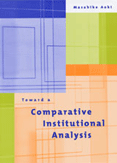|
|
Toward a Comparative Institutional Analysis is a monumental achievement offering an ambitious attempt to develop a unified theory of institutions, of the mechanisms of their reproduction over time and of the drivers of their change. The enterprise broadly belongs to the "neoinstitutionalist" perspective in that it searches for microformulations of the very existence and self-reproduction of institutions grounded on the interests and behaviors of self-seeking agents. However, it takes on board insights from diverse perspectives, including "stronger" forms of institutionalism from sociology and political science as well as anthropology. Govianni Dosi Professor, Sant'Anna School of Advanced Studies, Italy |
| Chapter 1. What are Institutions? How Should We Approach
Them? Part I. PROTO-INSTITUTIONS: INTRODUCING BASIC TYPES Chapter 2. Customary Property Right and Community Norms Chapter 3. The Private-Ordered Governance of Trade, Contracts, and Markets Chapter 4. Organizational Architecture and Governance Chapter 5. The Co-Evolution of Organizational Conventions and Human Asset Types Chapter 6. States as Stable Equilibria in the Polity Domain Part II. A GAME-THEORETIC FRAMEWORK FOR INSTITUTIONAL ANALYSIS Chapter 7. A Game-Theoretic Concept of Institutions Chapter 8. The Synchronic Structure of Institutional Linkage Chapter 9. Subjective-Game Models and the Mechanism of Institutional Change Chapter 10. Diachronic Linkages of Institutions Part III. AN ANALYSIS OF INSTITUTIONAL DIVERSITY Chapter 11. Comparative Corporate Governance Chapter 12. Types of Relational Financing and the Value of Tacit Knowledge Chapter 13. Institutional Complementarities, Co-Emergence, and Crises: The Case of the Japanese Main Bank System Chapter 14. Institutional Innovation of the Silicon Valley Model in the Product System Develpment Chapter 15. Epilogue: Why Does Institutional Diversity Continue to Evolve? |



